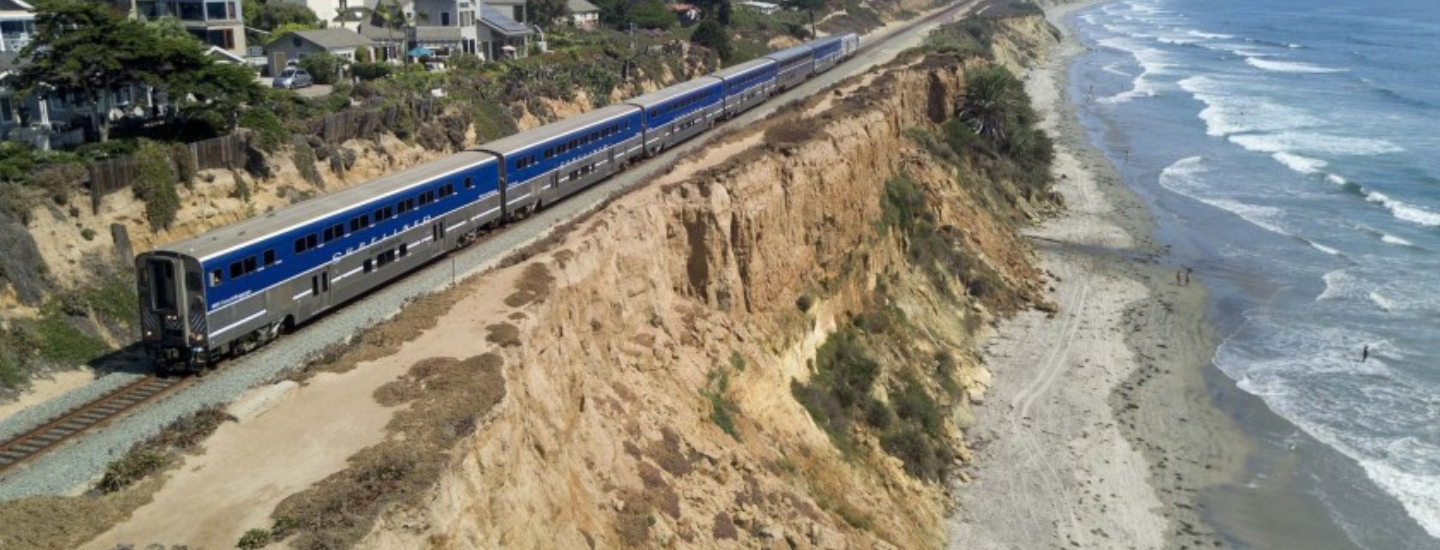
*For Oct 2020 updates related to the North County Transit District's petition to the Surface Transportation Board for a declaratory order and our response letter, click HERE
The LOSSAN railroad runs through a 1.7 mile stretch of highly unstable bluffs in Del Mar. The Surfrider Foundation acknowledges that these coastal bluffs provide important historic coastal access opportunities and are invaluable to the ecology and character of Del Mar. The Surfrider Foundation further acknowledges that the rail corridor is considered critical infrastructure by regional, state, and federal entities; and that as a public transit option it provides opportunities for enhancing equity and reducing greenhouse gas emissions from transportation. The safety threat related to the railroad’s position along the bluffs in Del Mar is not a new phenomena. The tracks themselves were once further inland and in 1910 were relocated to the present location. Since that time, three trains have fallen to the beach, the last time in 1941.
The San Diego Association of Governments (SANDAG), The North County Transportation District (NCTD), the City of Del Mar, and other stakeholders are evaluating long-term options for relocating this stretch of railroad in order to address these predictable — and now imminent — hazards related to the erosion of the bluffs. There is also strong motivation within the stakeholder group to double track this segment of the track for capacity building and safety reasons. Double tracking is not feasible at the present location due to the associated risks. SANDAG is examining five long-term relocation alternatives. In the short-term, a six-phased project is underway to provide immediate stabilization of the railway through approximately 2050.
We support the long-term relocation of the railway. Del Mar’s sensitive bluffs are an important source of habitat and coastal access; and dynamic beaches and bluffs must be given the space to erode. Armoring and stabilization will not ultimately be effective as the bluff is already eroding measurably every year at a rate that will increase significantly as sea levels rise. Relocation should be pursued as quickly as possible, though will not likely occur within the next two decades. In the meantime, the Surfrider Foundation is working proactively to ensure that short-term solutions for bluff stabilization are as adaptive as possible. Our region’s strategy to brace itself against ongoing erosion, which will accelerate with sea level rise, should not include measures that will result in disastrous impacts that far outlast the benefits of our measures.
The following all continue to be important factors in the LOSSAN rail situation in Del Mar:
- Landslides along the bluffs in Del Mar are frequent and relatively unpredictable, with a landslide in November 2019 occurring within feet of the tracks.
- Bluffs in the area are currently eroding at approximately .5 feet per year according to a geotechnical memorandum presented to the Coastal Commission in 2018.
- Erosion will accelerate such that the railway will be completely undermined in the near future according to a study by the City of Del Mar’s SLR Technical Advisory Committee’s (STAC) Coastal Hazards, Vulnerability, and Risk Assessments document.
- Urban water management practices result in large volumes of water discharging into drainage system, which contributes to erosion along Del Mar’s cliffs.
- Multiple surf breaks are enjoyed along this stretch of beach, including at Torrey Pines State Beach, 8th Street Del Mar Reef, 4th Street, etc. Wave refraction caused by narrowing beaches is already an issue impacting these breaks.
- Sea levels in Southern California are generally expected to rise approximately 1 foot by 2050 and 3 feet or potentially much higher by the end of the century, according to the San Diego Regional Report to California’s Fourth California Climate Change Assessment.
- Del Mar’s beaches and coastal assets drive economic activity around tourism and coastal recreation.
- The LOSSAN corridor is considered critical infrastructure, and rail service helps to meet greenhouse gas reduction targets for San Diego.
- Other vulnerable public infrastructure along the bluffs includes sewage and wastewater infrastructure.
Therefore, Surfrider supports:
- The long-term relocation of 1.5 miles of track along the bluff in Del Mar and any associated segments that need to be relocated to facilitate relocation off the bluff.
- Efforts to study and analyze ‘soft’ alternative options for stabilizing the bluffs in the next 20-30 years that minimize impacts to coastal resources.
- Analysis of the impacts of short-term bluff stabilization projects to coastal resources such as sand, waves, and coastal access; as well as opportunities for public review of such analyses.
- Mitigation from the negative impacts of seawalls, revetments and other hard structures that prevent the natural landward erosion of bluffs, in the form of both improved coastal access elsewhere and sand replenishment for impounded beach quality sand.
- Education, outreach, and city-led efforts to reduce urban runoff from the City of Del Mar.
- Continual monitoring of local sea level rise and erosion trends.
- Efforts to speed up the relocation of the tracks, including the identification and presentation of relocation alternatives, as well as investigation into relevant funding opportunities.
- Improvements to coastal access along the current bluff-top railway location.
- Efforts supporting the relocation of other infrastructure atop the bluffs, including sewage and wastewater infrastructure.
The San Diego Chapter of the Surfrider Foundation recognizes that this is an evolving situation. This statement is intended to be general in nature.
Read more in our August 6, 2020 letter to the California Coastal Commission regarding CC-0001-20, related to an after-the-fact consistency certification or emergency work conducted by SANDAG in late 2019.
